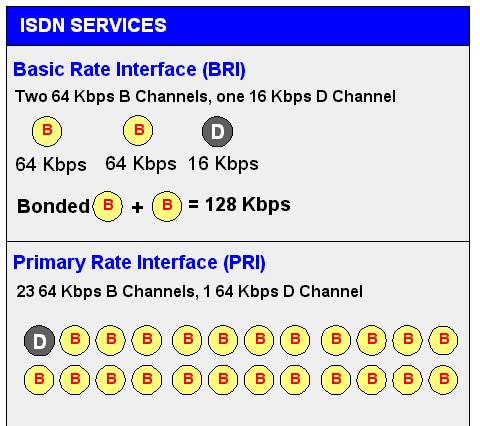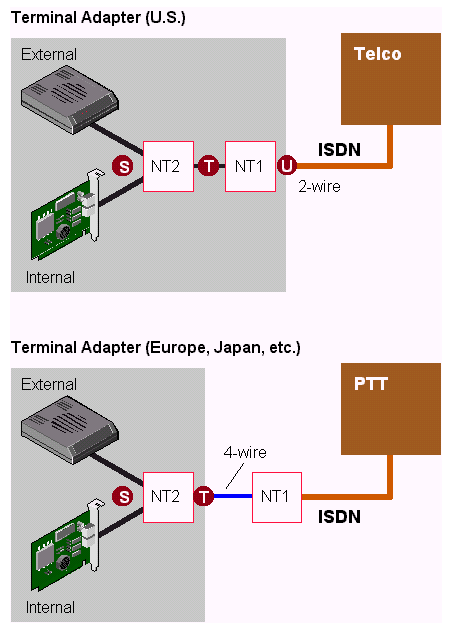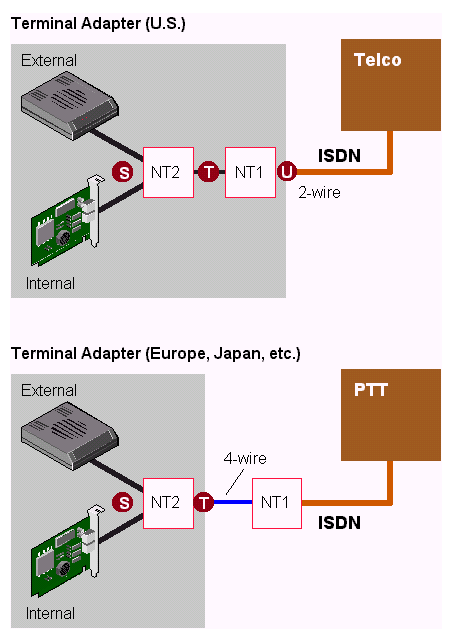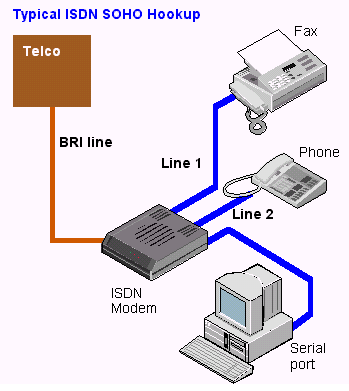ISDN
![]()
|
(Integrated Services Digital Network) An international
telecommunications standard for providing a digital service from the customer's premises
to the dial-up telephone network. ISDN turns one existing wire pair into two channels and
four wire pairs into 23 channels for the delivery of voice, data or video. Unlike an
analog modem, which converts digital signals into an equivalency in audio frequencies,
ISDN deals only with digital transmission. Analog telephones and fax machines are used
over ISDN lines, but their signals are converted into digital by the ISDN modem.

ISDN uses 64 Kbps circuit-switched channels, called "B channels" (bearer
channels), to carry voice and data. It uses a separate D channel (delta channel) for
control signals. The D channel signals the carrier's voice switch to make calls, put them
on hold and activate features such as conference calling and call forwarding. It also
receives information about incoming calls, such as the identity of the caller. Since the D
channel connects directly to the telephone system's SS7 signaling network, ISDN calls are
dialed much faster than regular telephone calls.

ISDN's basic service is BRI (Basic Rate Interface), which is made up of two 64 Kbps B
channels and one 16 Kbps D channel (2B+D). If both channels are combined into one, called
"bonding," the total data rate becomes 128 Kbps and is four and a half times the
bandwidth of a V.34 modem (28.8 Kbps)
 .
.
ISDN's high-speed service is PRI (Primary Rate Interface). It provides 23 B channels and
one 64 Kbps D channel (23B+D), which is equivalent to the 24 channels of a T1 line. When
several channels are bonded together, high data rates can be achieved. For example, it is
common to bond six channels for quality videoconferencing at 384 Kbps. In Europe, PRI
includes 30 B channels and one D channel, equivalent to an E1 line.
Connecting an ISDN Device
Connecting ISDN to a computer requires a network terminator (NT1)
and ISDN terminal adapter (TA). The NT1 plugs into the two-wire line from the telephone
company with an RJ-11 connector and provides four-wire output to the TA. Within the U.S.,
the NT1 is typically built into the TA; but in Europe and Japan, they are separate
devices.

Often called an "ISDN modem" because the device may
support an analog telephone or fax machine, the TA itself is technically not a modem,
because it provides a digital to digital connection. External TAs plug into the serial
port while internal TAs plug into an expansion slot. Some TAs hook into the parallel port
for higher speed. The TA may also include an analog modem and automatically switch between
analog and digital depending on the type of call.TAs support bonding for Internet
operation, which links the channels together for higher speed, but the ISP must provide
the Multilink PPP protocol (MPPP) to support this operation.

Although announced in the mid-1980s, it took more than a decade
before ISDN usage became widespread. When people asked when would it arrive, the answer
was ISDN: "I Still Don't Know."
The Terminal Adapter TAs in the U.S. generally have a built-in NT1 and attach via a
two-wire "U" interface. In Europe and Japan, the NT1 is installed by the
telephone company and attaches to the TA via a four-wire "T" interface. The NT2
component, which is built into most devices, is a logical interface for multiple access
and attaches via the "S" interface.
Typical SOHO Installation An ISDN terminal
adapter with phone support (ISDN modem) allows a telephone, fax machine and PC to
communicate via the ISDN service.
Typical LAN Installation LANs typically connect to ISDN via a router, which enables
multiple users to share the available channels. For Internet access, the router supplies
temporary IP addresses to each of the nodes. Routers may also provide analog phone
support.
![]()